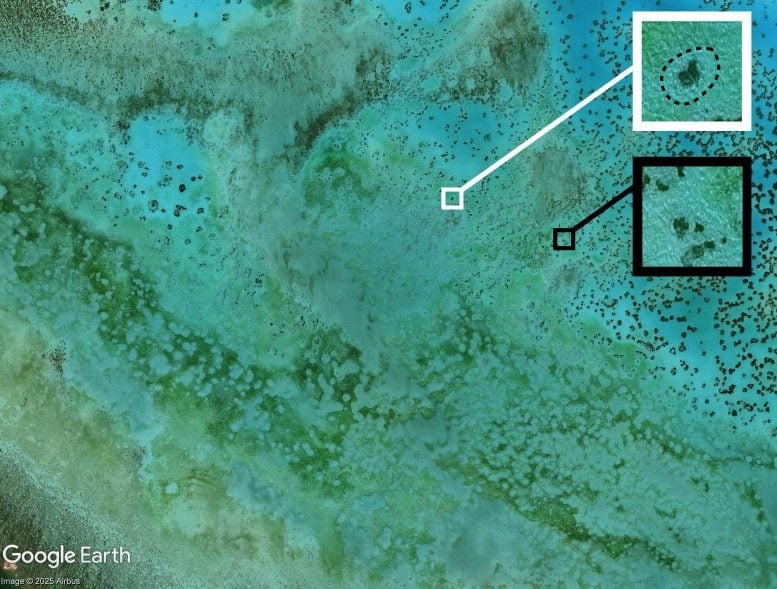What Causes the Mysterious “Ghostly” Halos Around Coral Reefs?
Modeling Reef Shelter and the Formation of Grazing Halos
A recent study published in The American Naturalist explores the connection between grazing halo patterns around coral reefs and the spatial distribution of shelter habitats. Since these ghostly halos only form around patches of shelter habitat, the researchers aimed to investigate how the arrangement of coral—whether clustered or spread out—affects halo formation across the seascape. Additionally, the team examined whether these patterns could serve as indicators of reef health or stress.

Figure 1. What’s Behind the Mysterious “Ghostly” Halos Around Coral Reefs?
To conduct their analysis, the researchers developed two mathematical models to assess how different clustering patterns influence halo formation. They then applied these models to real-world data, using satellite imagery from Heron Island in the Great Barrier Reef off Queensland, Australia, as a case study to test and validate their approach. Figure 1 shows What’s Behind the Mysterious “Ghostly” Halos Around Coral Reefs?
Halo Visibility Depends on Coral Clustering
Heron Island was chosen for this study due to its well-documented reef system and its relevance as part of the Great Barrier Reef, which faces significant threats from climate change. Coral bleaching, ocean acidification, extreme weather events, and habitat changes continue to endanger this fragile ecosystem.
In their first model, the researchers explored how the arrangement of coral shelters influences the visibility of grazing halos. Using simple geometric rules, they showed how the way circular habitat patches overlap affects the amount of surrounding vegetation.
“If the shelter habitat is tightly packed in one space, then there’s not much room for nervous prey to explore and less vegetation to eat,” explains lead author Theresa Ong, an assistant professor of environmental studies at Dartmouth. “But if shelter is more evenly distributed, the halos carve out more empty space in the landscape and their distinctive patterns disappear into one another as they overlap.”
In essence, when coral clusters are densely packed, individual halos are smaller and less distinct due to limited grazing zones. Conversely, when shelters are spread out, halos can extend farther but may overlap, making them harder to detect against the seascape.
Dynamic Modeling Reveals Cyclical Patterns in Halo Formation
To ensure broad applicability, the researchers designed their initial model to be general enough for any ecosystem where organisms graze near shelter—such as cattle grazing near trees in a pasture. However, because that model was static and assumed constant grazing over time, the team developed a second, dynamic model to explore how interactions between herbivores and vegetation might influence halo formation and persistence.
In healthier reef systems—where predator populations help regulate herbivore behavior—both stable and cyclical halo patterns can occur.
The researchers emphasize that monitoring how halo patterns change over time could be more valuable than simply measuring their size. These temporal shifts might offer deeper insights into the health and dynamics of reef ecosystems.
Halos Reflect Predator-Prey Dynamics
The researchers hypothesized that persistent, clearly defined halos are most likely to form in areas where shelter is clustered and herbivore activity is tightly constrained—typically by the presence of predators. However, they found that the appearance and disappearance of halos over time aligns well with the landscape of fear theory, which posits that prey animals change their behavior based on perceived predation risk. “That could explain why the link between halo widths and reef community health is weak,” says lead author Theresa Ong.
For halos to remain static, herbivores must be prevented from consuming all available vegetation—usually by predators. Without such limits, herbivore populations can overgraze, deplete their food source, crash, and then recover, creating natural cycles of vegetation loss and regrowth. These oscillations cause halos to grow, shrink, vanish, and reappear over time.
“This is typical predator-prey dynamics,” explains Ong. “Oscillating halos are not necessarily a sign of overfishing or poor reef health. What’s more concerning is if static halos suddenly start cycling or if cyclic halos suddenly become static. That could indicate a major shift in the system’s health and resilience.”
Because direct fieldwork on coral reefs is difficult—especially across large areas—satellite imagery offers a valuable tool for quickly assessing reef conditions. By identifying halo patterns from above, scientists can gain insights into reef health and predator-prey relationships at scale.
“There are many endemic species on reefs, particularly in the Great Barrier Reef, that are vulnerable to the combined pressures of climate change and overfishing,” says Ong. “Understanding how halo patterns reflect ecological dynamics may offer an important tool for conservation. Monitoring halos over time could help us detect whether predator populations are intact and the reef ecosystem is functioning properly.”
Source: SciTECHDaily
Cite this article:
Priyadharshini S (2025), What Causes the Mysterious “Ghostly” Halos Around Coral Reefs?, AnaTechMaz, pp.1141

